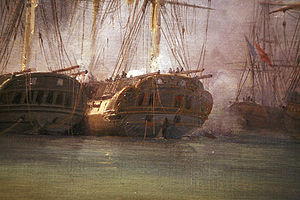| French frigate Minerve (1809) | |
|---|---|
 Minerve (centre) at the Battle of Grand Port. | |
| Career (Portugal) | |
| Name: | Minerva |
| Namesake: | Minerva |
| Captured: | 23 November 1809 |
| Career (France) | |
| Name: | Minerve |
| Acquired: | 22 November 1809 |
| Captured: | 3 December 1810 by the Royal Navy |
| Status: | Broken up |
| General characteristics | |
| Armament: | 48 guns |
Minerva was a 48-gun frigate of the Portuguese Navy. She was captured by the French in November 1809, then taken into service as Minerve.
Career[]
In November 1809 Minerva sailed to Brazil, under Captain Pinto.[1]
On 22 November 1809 she encountered the French frigate Bellone, under Captain Duperré. The distance between the two ships being too great for Duperré to catch them before nightfall, he shadowed Minerva until the next morning. On 23, at 9:00, Bellone had taken a favourable position behind Minerva, at pistol range. Understanding the advantage that this configuration gave to Bellone, Pinto turned, but the French followed and fired a raking broadside. Pinto then turned the other way, only to receive another broadside. Eventually, Minerva ran downwind, but Bellone followed and maintained fire, until Minverva surrendered. The fight had lasted for one hour and forty-five minutes.[2] Minerva was recommissioned as Minerve, and her command was given to Pierre Bouvet.[3] Duperré, hindered by the damage sustained by Bellone, the reduction and dispersion of his crew over his prizes, and the 500 prisoners he had aboard, decided to return to Ile de France, where he arrived on 2 January 1810, accompanied by Manche which they had met en route.
She was repaired and reconditioned, with her carronades replaced with 18-pounder short guns.[3]
The two ships sailed together, capturing the East Indiamen Windham and Ceylan in the Action of 3 July 1810. Returning to Île de France, the squadron fought in the Battle of Grand Port.
Minerve was surrendered to the British after the Invasion of Île de France in December 1810, and was broken up shortly thereafter.
Notes and references[]
Notes[]
References[]
Bibliography[]
- Roche, Jean-Michel (2005). Dictionnaire des bâtiments de la flotte de guerre française de Colbert à nos jours, 1671 - 1870. Group Retozel-Maury Millau. ISBN 978-2-9525917-0-6. OCLC 165892922.
- Troude, Onésime-Joachim (1867). Batailles navales de la France. 4. Challamel ainé. pp. 160–162. http://books.google.ch/books?id=zfFrDVTkcpsC&oe=UTF-8&redir_esc=y.
- (French) Les bâtiments ayant porté le nom de Minerve, netmarine.net
The original article can be found at French frigate Minerve (1809) and the edit history here.